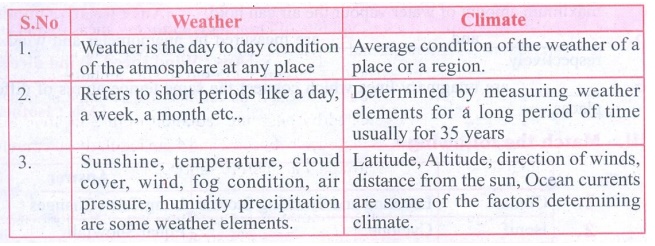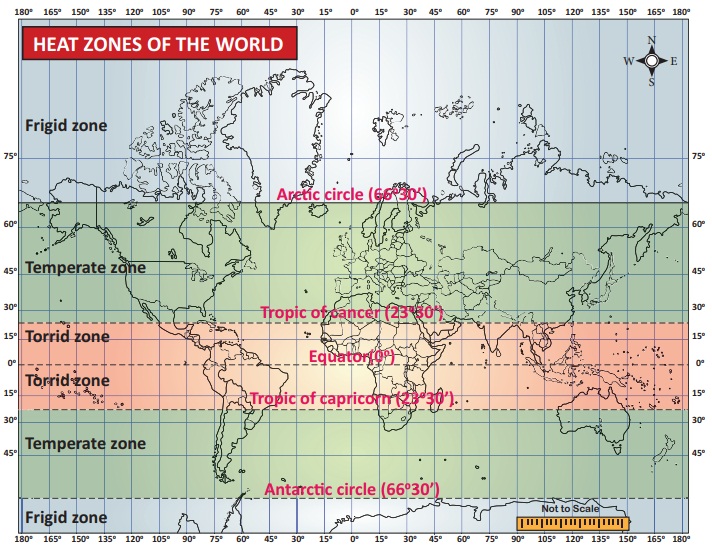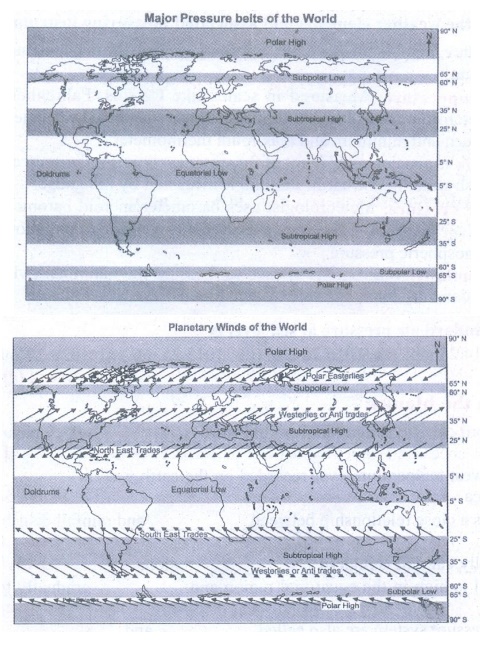Weather and Climate | Chapter 2 | Geography | 8th Social Science - Questions with Answers | 8th Social Science : Geography : Chapter 2 : Weather and Climate
Chapter: 8th Social Science : Geography : Chapter 2 : Weather and Climate
Questions with Answers
Evaluation
I. Choose the correct answer
1. Earth's atmosphere contains about ____________ percentage of nitrogen and oxygen.
a. 78% and 21%
b. 22% and 1%
c. 21% and 0.97%
d. 10% and 20%
[Answer: (a) 78% and 21%]
2. ____________ is generally defined as the average conditions of the weather of a place or a region.
a. earth
b. atmosphere
c. climate
d. sun
[Answer: (c) climate]
3. The earth receives energy from ____________.
a. current
b. electro magnetic radiation
c. waves
d. heat
[Answer: (d) heat]
4. Which one the following represents places with equal amount of rainfall
a. isotherm
b. isohel
c. isobar
d. isohytes
[Answer: (d) isohyets]
5. ____________ is used to measure the humidity.
a. anemometer
b. barometer
c. hygrometer
d. thermometer
[Answer: (c) hygrometer]
II Fill in the blanks
1. Weather refers to the condition of atmosphere for a short period of time.
2. The scientific study of weather is called Meterology.
3. The highest temperature ever recorded on the earth is 56.7°C.
4. Relative humidity is a ratio between the actual amount of water vapour and the maximum amount of water vapour the air can hold.
5. Wind speed and Wind direction are measured by anemometer and wind vane respectively.
6. Isotherms are imaginary lines which connect the same temperatures of different places.
III Match the following
1. Climate - Locating and Tracking Storms
2. Isonif - Cyclone
3. Hygrometer - Equal Snowfall
4. Radar - Long Term Changes
5. Low Pressure – Humidity
Answer
1. Climate - Locating and Tracking Storms - Long Term Changes
2. Isonif – Cyclone - Equal Snowfall
3. Hygrometer - Equal Snowfall - Humidity
4. Radar - Long Term Changes - Locating and Tracking Storms
5. Low Pressure - Humidity – Cyclone
IV State whether the following statements are True or False
1. The atmosphere is a layer of gases surrounding the planet. [Answer: True]
2. The Scientific study of weather is called Climatology. [Answer: False]
Correct statement: The Scientific study of weather is called meterolo.
3. Isohel refers equal sunshine. [Answer: True]
4. Humidity is calculated by Aneroid Barometer. [Answer: False]
Correct statement: Air pressure is calculated by Aneroid Barometer.
V Answer briefly
1. Define ‘weather’.
Answer: Weather is the day today conditions(state) of the atmosphere at any place as regards sunshine, temperature, cloud cover, Wind fog condition, air pressure, humidity, precipitation and such other elements.
2. What is insolation?
Answer: Insolation is the solar radiation that reaches the earth’s surface. The earth and its atmosphere get heated from the sun through insolation.
3. What is meant by atmospheric pressure?
Answer: The weight of air above a given area on the earth’s surface is called atmospheric pressure or air pressure.
4. Write a short note on “Planetary winds”
Answer:
(i) Planetary Winds are the ones which blow almost in the same direction throughout the year. So, they are called as Permanent or planetary winds.
(ii) Trade winds, Westerlies and polar easterlies are the types of prevailing winds.
5. What are “Isolines”?
Answer: Distribution of weather elements are shown by means of Isolines on maps. Isolines are lines which join the places of equal values of weather elements.
VI Distinguish between
1. Weather and climate.
Answer:

Weather
I. Weather is the day to day condition of the atmosphere at any place.
2. Refers to short periods like a day, a week, a month etc.,
3. Sunshine, temperature, cloud cover, wind, fog condition, air pressure, humidity precipitation are some weather elements.
Climate
1. Average condition of the weather of a place or a region.
2. Determined by measuring weather elements for a long period of time usually for 35 years
3. Latitude, Altitude, direction of winds, distance from the sun, Ocean currents are some of the factors determining climate.
2. Absolute and relative humidity.

Absolute humidity
1. Mass or weight of water vapour present per unit volume of air.
2. Expressed usually in grams per cubic metre of air.
Relative humidity
1. Ratio between the actual amount of water vapour present in the air and the maximum amount of water vapour it can hold at a given temperature.
2. Expressed as a percentage.
3. Permanent and seasonal winds.
Answer:

Permanent winds
1. The ones which blow almost in the same direction throughout the year.
2. Also called Planetary winds. Eg., Trade wings, Weather winds
Seasonal winds
1. Winds which change their direction according to season in a year. Blow from sea to land in summer and land to sea in winter.
2. Also called Monsoon winds. Eg., North east monsoon winds, South west monsoon winds
VII Give reasons
1. The Weather and climate in different regions vary.
Answer: Angle of the sun’s rays, the length of daytime, altitude, distribution of land and water bodies, location and direction of mountain ranges, air pressure, winds and ocean currents are the major factors which affect the weather and climate of a region.
2. Temperature decreases with increase in altitude.
Answer: Temperature varies both horizontally and vertically. Temperature always decreases with increasing height is known as Lapse rate which is 6.5 degree Celsius per 1000 meters in troposphere.
3. Mountain climbers carry oxygen cylinders while ascending peaks.
Answer: With decreasing air pressure, the availability of oxygen to breath also decreases. At very high altitudes, atmospheric pressure and available oxygen get so low that people can become sick and even die. Mountain climbers use bottled oxygen when they ascend very high peaks.
VIII Answer in a paragraph
1. How is temperature measured?
Answer:
Measuring Temperature:
(i) The temperature of a unit volume of air at a given time is measured in scales like Celsius, Fahrenheit, and Kelvin. Meteorologist measures the temperature by the Thermometer, Stevenson screen and minimum and maximum Thermometer.
(ii) The energy received by the earth through insolation is lost by outgoing radiation.
(iii) Atmosphere is mainly heated by outgoing radiation from 2 to 4pm. So the maximum temperature is recorded between 2 and 4 pm regularly and minimum temperature is recorded around 4 am before sunrise.
Mean Temperature:
(i) The average of maximum and minimum temperatures within 24 hours is called mean daily temperature [(87°F+73°F) / 2=80°F].
(ii) Diurnal range of temperature is the difference between the maximum and minimum temperatures of a day. Annual range of temperature is the difference between the highest and lowest mean monthly temperatures of a year.
2. Write about the wind and its types.
Answer: The horizontal movement of air is called wind.
The wind systems are broadly categorized into three as follows.
(i) Planetary winds
(ii) Seasonal winds
(iii) Local winds
(i) Planetary Winds are the ones which blow almost in the same direction throughout the year. So, they are called as Permanent or planetary winds. Trade winds, Westerlies and polar easterlies are the types of prevailing winds.
(ii) Seasonal winds are those which change their direction according to season in a year. They are called as monsoon winds. These winds blow from sea to land during summer and land to sea during winter.
(iii) Local winds, are the winds blow over a small area only during a particular time of a day or a short period of a year. Land and sea breezes are example of these winds.
3. List out the weather elements and associated measuring instruments.
Answer: Temperature, rainfall, pressure, humidity and wind are the major elements of weather and climate.
(i) Temperature: Measured in scales like Celsius, Fahrenheit and Kelvin. Meterorologists Measure the temperature by the Thermometer. Stevenson screen and minimum and maximum thermometer.
(ii) Rain is a major component of the water cycle and is the source of most of the fresh water on the earth. Rainfall is measured by raingauge.
(iii) Air Pressure: Meteorologist uses barometer/aneroid barometer to measure the air pressure. Barograms are used for recording continuous variation in atmospheric pressure.
(iv) Humidity: Hygrometer is used to measure the humidity, (which comprises wet and dry bulbplate side by side in the Stevenson screen)
(v) Wind:
(a) Meteorologist measures wind direction using wind vane or weather cock. Wind speed is measured by anemometer. Wind need rose is a diagram used to depict the direction and periods (No. of days) of prevailing winds on map.
(b) Meteorograph or triple register is an instrument which records wind speed and direction, sunshine and precipitation. It also provides graphic representation.
IX 1. Give any three suggestions to reduce global warming
1. ______________.
2. ______________.
3. ______________.
Answer:
1. Switching over to renewable energy sources.
2. Reduce water wastage
3. Shrinking carbon profile.
2. Map Activity
On the outline map of world mark the following
1. Heat zones of the world

2. Pressure belt and planetary winds

X Activities
1. Make weather instruments like wind vane and rain gauge using web resources.
2. Make mini-meteorological station model in your school.
3. Observe and record the weather condition of your place in the following table.

Related Topics